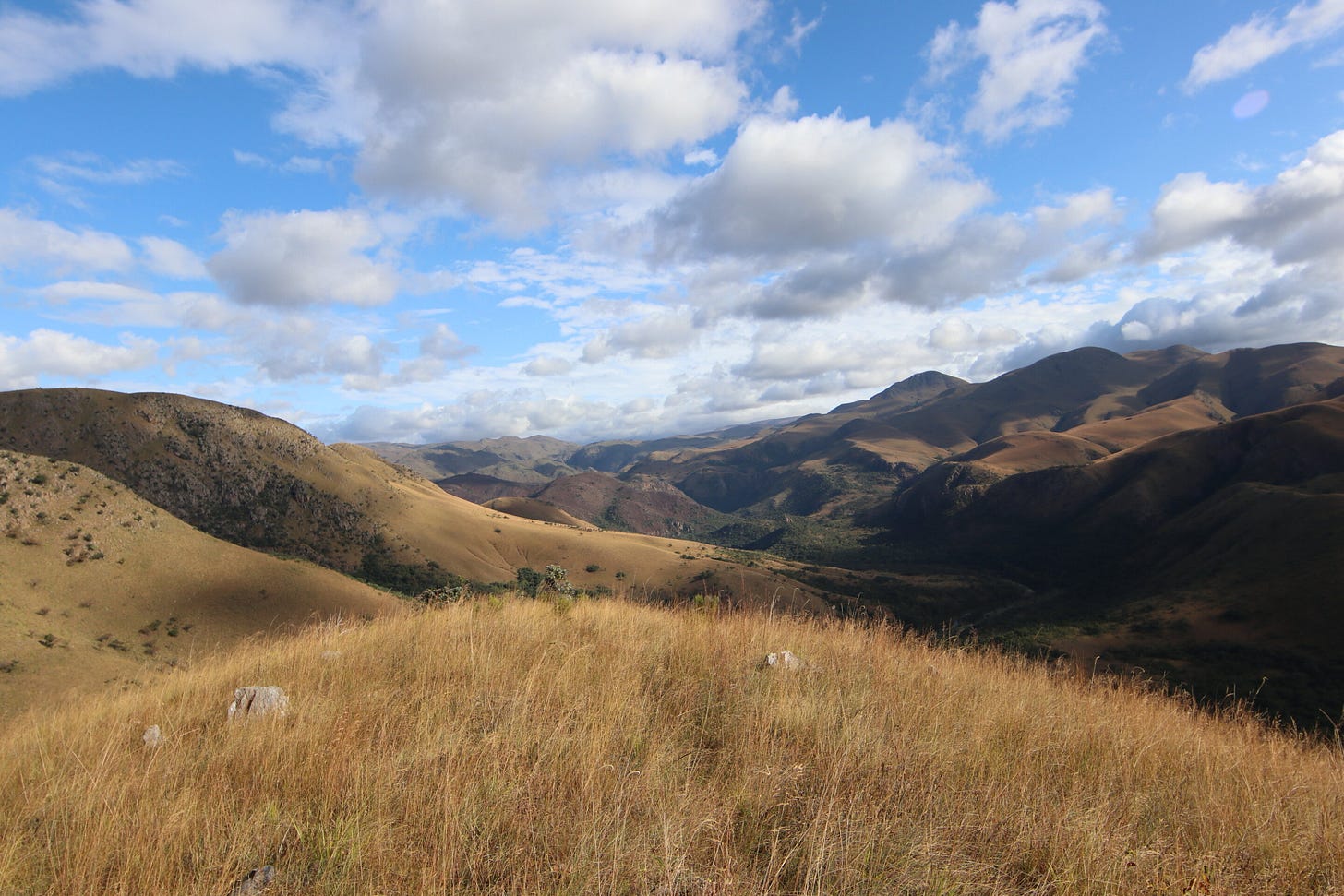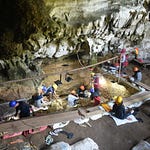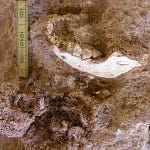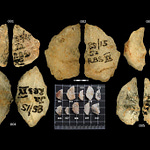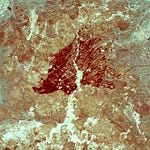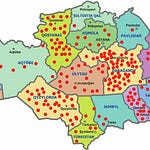In the highlands of Eswatini, long before kingdoms were carved or borders drawn, ancient hunter-gatherers trekked across rugged terrain in pursuit of a simple but telling goal: the right kind of rock. Not just any rock. Not just the nearest one. But red jasper and green chalcedony, prized not only for their workability in toolmaking but perhaps also for their sheen, hue, and symbolic weight.
A new study published in the Journal of Archaeological Science1 offers one of the clearest windows yet into how Paleolithic humans in southern Africa weighed material, movement, and meaning. Drawing on geochemical analysis, GIS-based landscape modeling, and legacy museum collections, the authors reconstruct the ancient foraging strategies behind stone tool production during the Middle and Later Stone Age in Eswatini.
The key insight: prehistoric people weren’t merely scraping by with the rocks nearest their camps. They were making deliberate, sometimes arduous decisions to carry vibrant stones across hills and valleys, perhaps for reasons that weren’t entirely functional.
“Colorful and shiny materials seemed attractive to early humans; they often used them for their tools,” noted study lead Gregor Bader. “We can only speculate as to whether the colors had a symbolic meaning.”
The Quest for Colorful Stone
When archaeologists began to analyze assemblages of chipped stone artifacts from several sites in Eswatini—Sibebe, Hlalakahle, Nkambeni, and Siphiso—they noticed something peculiar. Despite being surrounded by plenty of workable stone, early toolmakers had sometimes gone out of their way to acquire specific kinds of chert, a cryptocrystalline rock commonly used in prehistory.
Not just any chert: red jasper, green chalcedony, and black chert appeared selectively and at times in great distance from their known geological sources. The researchers identified these primary sources in the Mgwayiza Valley, within the protected Malolotja Nature Reserve near the South African border.
Using Neutron Activation Analysis (NAA), the team matched tiny lithic flakes from archaeological sites to these geological outcrops. Their conclusion? Some groups traveled up to 100 kilometers to collect these colorful rocks, often ignoring more easily accessible raw materials along the way.
Rivers, Routes, and Trade-offs
Through digital modeling of topography and ancient walking paths, the team calculated least-cost paths from these source areas to the archaeological sites. For example, red jasper was hauled nearly 30 kilometers to Sibebe, while green chalcedony turned up at Hlalakahle despite being over 10 kilometers away. At Siphiso, 99 kilometers from the red jasper source, the material was still present—suggesting long-distance movement or exchange.
“Even if we assume that the hunter–gatherers took the shortest routes,” Bader wrote, “we still find considerable distances between the rock deposits and the places where the stones were used.”
The findings raise key questions about mobility, memory, and value in forager societies. Was the acquisition of these stones embedded in seasonal circuits of movement? Were certain individuals tasked with collecting materials from sacred or symbolically charged places? Or were the stones exchanged among distant groups as social gifts?
Red for Later, Green for Before
The temporal pattern of raw material use also stood out. During the final phase of the Middle Stone Age (ca. 40,000 to 28,000 years ago), green chalcedony and black chert dominated toolkits. But by the Later Stone Age (ca. 30,000 to 2,000 years ago), red jasper took center stage.
Despite both stones being located in the same valley and accessible by similar paths, early communities shifted their preferences over time. One possibility is that red jasper took on new social or symbolic meanings, prompting its rise in popularity. Another is that evolving tool types or cultural practices favored the bright red stone.
“Both colors occurred close together in the same valley,” the authors observed, “so we can assume a deliberate selection of different materials at different times.”
The red jasper used during the Later Stone Age also showed a high “retouch index,” meaning it was frequently modified into tools after its initial use. This points to a kind of curation: stone kept, carried, and reshaped rather than discarded, reflecting its heightened value.
Was It Just the Color?
The distinction between raw materials wasn’t purely technological. Red jasper, for instance, wasn’t clearly superior in terms of durability or flaking properties. And yet it was chosen over other stones and transported across vast stretches of rugged terrain.
The authors suggest aesthetic or symbolic motivations might have driven these choices. The red hue of jasper has long been associated with blood, fertility, and life in many global traditions. Similarly, green chalcedony or chrysoprase may have evoked verdant associations or simply stood out visually in otherwise earthy landscapes.
“This study shows that aesthetic qualities and symbolic potential could shape practical decisions about which materials to use,” says Brandi MacDonald, co-author and archaeological scientist at the University of Missouri.
Stones That Tell Stories
This research demonstrates that Paleolithic hunter-gatherers were not passive opportunists limited by geography. They were selective, strategic, and perhaps even sentimental in their use of natural materials. Their tools weren’t just objects of survival but reflections of knowledge, movement, and shared aesthetic choices.
In modern terms, it’s not unlike a woodworker today driving out of town to find a particular species of timber—not because it’s stronger or more abundant, but because it looks and feels right for the task.
The discovery also highlights the value of museum collections and interdisciplinary collaboration. The team’s access to legacy material from past excavations, paired with modern analytical tools, made it possible to reconstruct ancient lifeways across thousands of years.
As climate change and mining operations threaten many of these source areas, the urgency of documenting such practices grows sharper.
“Prehistoric people treated stone like we treat memory,” one researcher commented, “carving meaning into material, and moving it far beyond the place it began.”
Related Research
Mackay, A., Stewart, B. A., & Chase, B. M. (2021).
Raw material transport and the emergence of complexity in the Still Bay of South Africa.
Journal of Human Evolution, 154, 102968.
https://doi.org/10.1016/j.jhevol.2021.102968Dayet, L., et al. (2016).
Ochre resources and the evolution of symbolic behavior in the Middle Stone Age.
PLOS ONE, 11(5), e0155840.
https://doi.org/10.1371/journal.pone.0155840Wadley, L. (2015).
Those marvellous millennia: The Middle Stone Age of southern Africa.
Azania: Archaeological Research in Africa, 50(2), 155–226.
https://doi.org/10.1080/0067270X.2015.1039236Masia, D. P. (2022).
Raw material variation and procurement in Limpopo Basin lithic technologies.
African Archaeological Review, 39(4), 541–568.
https://doi.org/10.1007/s10437-022-09526-w
Bader, G. D., Sommer, C., Linstädter, J., Masia, D. P., Blessing, M. A., Forrester, B., & MacDonald, B. L. (2025). Decoding hunter-gatherer-knowledge and selective choice of lithic raw materials during the Middle and Later Stone Age in Eswatini. Journal of Archaeological Science, 180(106302), 106302. https://doi.org/10.1016/j.jas.2025.106302


